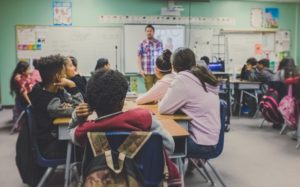As educators, it is our responsibility to provide equal opportunities for all students and do our best to meet the needs of all students despite social, cultural, or economic backgrounds. This may seem like an evident part of teaching, but challenges may arise when moving to an online setting as we discussed in topic 2 the importance of fostering relationships. This week’s readings provide key examples of how to reach out to students and support all in meaningful and relevant contexts.
In chapter 43 of the “Handbook of Research on K-12 Blended Learning Second Edition”, Bashman et al. (2018) discuss the framework of Universal Design for Learning (UDL) which was initially developed as “an approach for ensuring the effective inclusion of students with disabilities and diverse learning needs” but now applies to all learners (p.477). One of the main focus points of UDL is “harnessing technology and instructional practices to remove barriers in curricula and across… learning environments”(Bashman et al., 2018, p.480). The UDL guidelines have been broken down into 3 main principles which help to understand the why, what, and how of learning.
- Multiple means of engagement refers to the “ways to support the affective state and motivational connection to learning”(Bashman et al., 2018, p.483). This may look like giving students autonomy, agency, and motivation with tasks or assignments around the classroom.
- Multiple means of representation refers to the“ways that we sense and perceive information “recognition” networks that occupy the posterior regions of the brain”(Bashman et al., 2018, p.483). An example of this might be adding subtitles to videos so that students who are learning English can read along.
- Multiple means of expression and action refers to the “ways that we organize and execute strategies and actions through executive and motor cortices that occupy the frontal lobes”(Bashman et al., 2018, p.483). A teacher can allow students to represent their learning in a different format such as a video instead of an essay.
Check out this quick video that elaborates on some of the key components of UDL!
In the second reading, Kral and Schwab (2012) discuss the eight design principles taken into consideration when designing a learning environment. The focus of this article is on Indigenous youth in Australia and their “access to resources and a space that is conducive to the enactment of literacy practices” (Kral & Schwab, 2012, p.59). I think this is a critical aspect that Canadian educators must consider as there is a large population of Indigenous students who need a safe place to create, explore, and learn with access to proper resources and supportive teachers. This will ensure equity amongst students as designing an inclusive space can promote collaboration and connection.
The third website looks at how online learning has impacted classrooms during the current Covid-19 pandemic. Slewyn (2020) discusses some of the problems that have arisen over the past several months with a quick adjustment to online learning. He highlights how emotionally challenging online learning can be and how “the limitless and abundant nature of digital technologies, teachers and students are finding that remote online schooling requires clear boundaries in order to be manageable” (Slewyn, 2020). It is easy to be overwhelmed by the capabilities of the internet, but in order to deliver authentic learning experiences, teachers must prioritize the emotional well-being of their students. I hope to learn more about how to teachers find a balance between synchronous and asynchronous learning opportunities in a distributed or open learning environment.
– Ms. G 🙂
Resources
[AHEAD]. (2017, November 2). What is Universal Design for Learning (UDL)? [Video]. YouTube. https://www.youtube.com/watch?v=AGQ_7K35ysA
Basham, J.D., Blackorby, J., Stahl, S. & Zhang, L. (2018) Universal Design for Learning Because Students are (the) Variable. In R. Ferdig & K. Kennedy (Eds.), Handbook of research on K-12 online and blended learning (pp. 477-507). Pittsburgh, PA: Carnegie Mellon University ETC Press.
Kral, I. & Schwab, R.G. (2012). Chapter 4: Design Principles for Indigenous Learning Spaces. Safe Learning Spaces. Youth, Literacy and New Media in Remote Indigenous Australia. ANU Press. http://doi.org/10.22459/LS.08.2012 Retrieved from: http://press-files.anu.edu.au/downloads/press/p197731/pdf/ch041.pdf
Selwyn. N. (2020). Online learning: Rethinking teachers’ ‘digital competence’ in light of COVID-19.[Weblog]. Retrieved from: https://lens.monash.edu/@education/2020/04/30/1380217/online-learning-rethinking-teachers-digital-competence-in-light-of-covid-19




